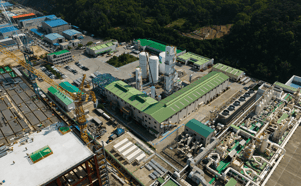GLOBAL analysis – what’s driving growth?
The market should maintain a healthy rate of growth in 2007, with an estimated 7-8 percent increase in volume over the next 5 years. With our global theme, we take this opportunity to look at the key drivers for growth this year. Also, following the issuing of 2006’s financial reports, we examine the costs and the cash behind last year’s revenues and acquisitions of the major gas companies.
2006 – A review
2006 closed on a high, with good growth and a level of M&A activity not seen for some time. Steel is the big story of recent years, proving a major driver to growth. Demand from the petrochemical and pharmaceutical industries has remained buoyant, despite high oil prices. The refining capacity of the oil industry reached a maximum output last year, making a positive impact on industry sales. New plants were also a feature, with new ASU’s and hydrogen plants planned and coming on-stream. Oxygen capacity also proved a boom sector this year with considerable growth in China and Asia.
Oil & chemicals
The global chemical industry still appears to be in an expansionary mode with year on year growth 2006/2007 expected of around 4.4 percent, although leading indicators of global industrial production suggest that the current growth cycle may have peaked. However, gas sales to the chemical industry show the best rate of growth amongst the end user market, with a 12 percent increase. This is fueled by the continuing demand for plastics such as polyethylene and we foresee continuing growth in fertilisers, chemicals and pharmaceuticals. We expect average annual increases of around 9 percent through to 2010.
The oil industry is also a growth market with refineries outsourcing their hydrogen needs, and high oil prices increasing capital expenditure projects that use gas technologies. Using enhanced oil recovery or EOR, oil is squeezed from old or tired wells by injecting nitrogen or CO2 into them to recover further supplies. Some gas companies are now focusing hard on the EOR applications, and Steve Angel from Praxair explains more in this month’s interview. Analysts believe that outsourced hydrogen demand will continue to grow, with a conservative estimate of 10 percent annually past 2010.
Metallurgy (Steel and non-ferrous)
Between now and 2015, global steel demand is likely to grow by 3.5 percent a year, with China’s needs expanding at 4-5 percent, and those of the rest of the world at 3 percent. Analysts suggest that the industry may become less dependent on China as Japan’s construction sector revives and demand reaches a rhythm in South America and Eastern Europe. But, as in so many other fields, hopes of expanding the market for steel are focusing on India, where potential for growth remains high.
With modern day steel mills consuming more oxygen per ton of steel produced than 20 years ago, industrial gas demand in the metallurgy sector has more than doubled this decade. Led by China, rises in demand have led to a series of upgrades, revamps and expansions across the globe, as well as new steelworks. The availability of natural resources is an important factor in the growth of the steel industry, and countries with coke deposits such as Brazil, Russia and India should grow rapidly. Between 2000 and 2005 the metallurgical gas market grew 8.6 percent and we expect a smooth onward path to 2010 of around the same figure.
Manufacturing
Although rates of expansion for production and new orders have moderated, conditions in the global manufacturing sector remain solid overall. Growth in 2006 was split well between consumer and business lines and for 2007, rising industry consumption and business investment will both have an impact. A new round of industry restructuring provides an opportunity for China to become a strong player in the manufacturing sector, and the extensive application of information technology is quickening industrialization dramatically across the developing world.
Gas use in this sector covers a wide range of applications, and construction activity is likely to remain a key growth area as infrastructure development increases in the emerging economies.
An increase in quality of life and expectations should also fuel demand for luxury products such as cars and white goods, which will expand the potential for gas usage. From 2000 to 2005 the manufacturing gas market achieved an average 5.4 percent growth per year but analysts expect this to rise (due to bullish manufacturing plans) to above 7 percent per annum by 2010.
... to continue reading you must be subscribed









